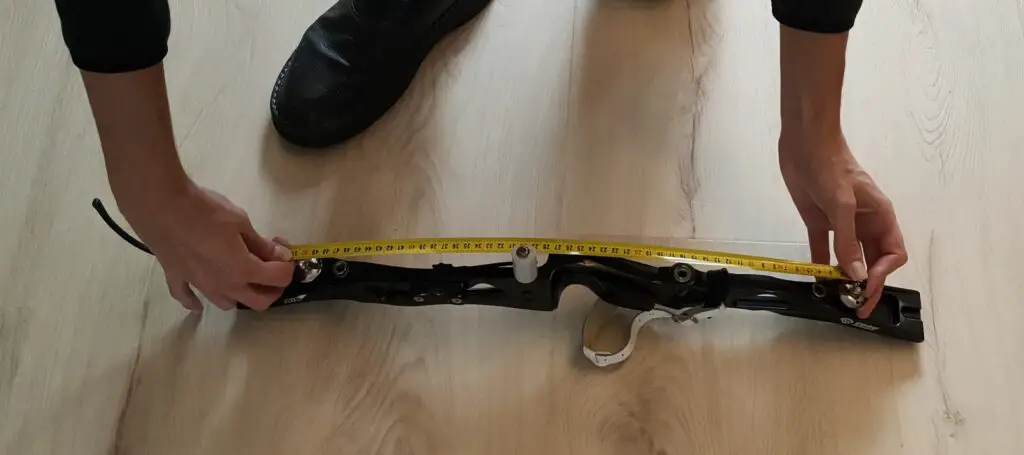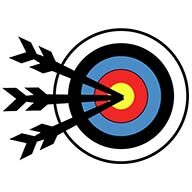Almost all takedown recurve limbs have a small white sticker with some numbers on it. People that are new to the sport often wonder what these numbers mean. Therefore, I will explain what these numbers mean and why they are important. Don’t care about the details? Read the bold section below for a quick answer to the question of the title.
The numbers on your limb indicate the draw weight at two different riser lengths (25 and 23 inches). The number in the middle indicates the total bow length (between 70 and 50 inches). Most adults use a 25-inch riser and should look at the upper two numbers to find the bow length and draw weight.
In the remainder of this article, I will explain in more detail what these numbers mean exactly. I will also explain why draw weight is higher on shorter risers, why we normally don’t use a short riser, and why the upper and lower limbs are labeled. So, keep reading, if you want to learn more about archery!
What the numbers mean
Alright, in case you’re still confused about what these numbers mean, let’s discuss it in a bit more detail. In the picture below you see two lines with each 3 numbers, the sticker on your limb might be slightly different, but it should look similar
The first number 25H means to the riser the limb is tested on. The second number 70 refers to the total length of the bow (the riser + the bow limbs). And the last number means the draw weight at that configuration.
The limb in this example when placed on a 25-inch riser has a total length of 70 inches and a draw weight of 30 LBS. If you are using a 23-inch riser the total length is 68 and the draw weight will be 32. So, the draw weight increases with 2 LBS. We discuss why this happens later in the article
You can see that the total length of the bow decreases by 2 inches, when you use a smaller riser, since it’s also 2 inches smaller. With this information, you could also calculate the length of one limb, (70 – 25) / 2 = 22 ½ inches. We don’t use that number in archery, but I think it makes it easier to understand what these numbers mean exactly.

Why these numbers are important
You might wonder, why do I even need these numbers. Why does the length and draw weight of my bow matter? In this section, I will explain why archers find these numbers important and how we use them. Let’s start with the first number.
Riser length
The length of the riser itself isn’t an important statistic except that it influences the total length of the bow. Since we use this metric, we need to know the length of our riser. Most adults will use a 25-inch riser. We will discuss why later in this article.
Bow length
We often use the total bow length to determine the length of the string. Shorter bows need shorter strings while longer bows need longer strings. Makes sense right! Most often we measure our old string to determine the right length because that is more precise. But if you have lost your string or it broke, we can use this trick to determine the length of our replacement string.
For takedown recurve bows we subtract 4 inches from the total length of the bow to get the right string length. For my bow, this would be 70 – 4 = 66 inches. Read the article below if you want to know more about strings and how to determine the right length of your string:
How to choose the right bowstring
Draw weight
The draw weight influences a lot of dynamics of your bow. It influences what kind of arrows you need, the required tension of your plunger, the placement of your sight, and so much more. Therefore, draw weight is one of the most important metrics of your bow.
Since there is so much to discuss about draw weight, I have written an in-depth article on this topic:
I do not only explain how to measure draw weight, but also how it influences your bow.
How to measure your riser
As I mentioned earlier, most adults will use a long riser; but in some cases, it might be worth double-checking the length of your riser. In case you have bought your riser second-hand.
Like many things, it might seem easy to measure your riser length, just measure the full length, right? Well no, we don’t do that because different limb fittings (for example ILF and Formula) have different sizes.
Therefore, we measure the length of your riser as follows:
Measure from the center of the limb bolt to the other center of the limb bolt and add 5 inches to get the length of the riser. Take this measurement along the curvature of the riser.
Example: If I measure from limb bolt to limb bolt, I get 20 inches (51 cm), when I add 5 inches, I get 25 inches. Therefore, I am using a long 25-inch riser. It might be difficult to get an exact measurement, but since most recurve risers are either 25 or 23 inches that don’t matter.

How to measure the length of your bow
Just like measuring the length of your riser, measuring the length of your bow seems simple. But we don’t measure the length from tip to tip in a straight line. The actual measurement doesn’t make that much sense. Because at the limb tips you follow the curvature of the bow but in the middle section, we measure it in a straight line.
Measure from the center grove of the upper limb to the center grove of the lower limb. Measure along the recurves but hold the measuring tape in a straight line between the two limbs like it’s the string of the bow. The measuring tape should only touch the limbs and not the riser.
See the video below for a demonstration:
Why draw weight is higher on shorter risers
You might wonder why the draw weight is higher on shorter risers. Everything stays the same, except the length of the bow, right? Does that make that much of a difference?
To fully explain it I must discuss the dynamics of the bow, but that is out of scope of this article. Therefore, I will only give a short explanation. If you are interested in the full story, please let me know! I might write a full-length article around this question.
Draw weight is higher on shorter risers than longer risers because the string is shorter. Due to the shortened string, the limbs bend further back storing more energy.
It all has to do with how much you bend the limbs per inch of your draw. The bigger your bow, the less your limbs must bend back to reach your draw length.
The benefit of a long riser
The previous section might make it seem like shorter risers are better. They are more compact, lighter and increase the draw weight of the bow. Still, most archers, use a long riser. In this section, I will explain why.
Safer at long draw lengths
The first major benefit of a long riser is that it’s safer. The more you bend your limbs the more likely your limb is to break. Since the riser decreases the amount the limb bends it’s safer to use a long riser on long draw lengths (>28 inches).
Therefore, we use smaller risers primarily for children’s bows. Since they don’t have a long draw length, it’s much safer for them then for a fully grown adult.
Larger sight window
If you aim with a sight, you look through the so-called sight window. This is the cutout which allows you to aim straight to the target.
On smaller risers, manufacturers often must decrease the size of the sight window. For most archers that don’t matter, but some might not be able to aim correctly, because the frame of the riser blocks the sight picture.
Especially for people with larger heads and a heavy draw weight, this might cause issues at short range.

Less stacking
Normally when you pull the bow back, your draw weight should increase steadily along with you’re your draw length. With each inch you pull back there should be a steady increase in draw weight. Therefore, the draw weight should increase linearly.
When you experience stacking, the bow increases in draw weight much more at the end of the draw. This makes it more difficult to keep your bow at full draw and makes your bow act less predictable. Therefore, archers always want to prevent stacking.


Stacking happens when you overdraw a bow. The limbs must bend further back than the bow was designed for. Since your bow limbs bend less far on the long riser, you will only experience stacking issues at extreme draw lengths (31 inches or more). In general, the draw feels smoother on a longer riser.
More forgiving
A light bow (in terms of mass) seems like an advantage, right? It makes it easier to wield and requires less muscle energy to keep it upright. Although that’s true, most experienced, and trained archers prefer a heavier riser. The reason behind this is that heavier risers absorb more vibration.
Whenever you hold a bow, you will always shake a little. It’s simply not possible to keep your arm 100% still. Since heavier objects require more energy to move, a heavier riser will absorb more of the vibration. For more information on how archers can reduce the vibration on their bow, read the article below:
How to remove vibration from your bow
Therefore, having a larger and heavier riser is often seen as an advantage instead of a disadvantage.
Less finger pinch
Finger pinch refers to the feeling you get when your fingers are forced in an unnatural position. When you are drawing a bow. The bowstring will start to create a triangle. The archer holds the bow at one of the corners. The steeper the triangle the more uncomfortable it will be to shoot the bow. That’s why compound archers use a release. It’s just not comfortable to shoot that bow with your fingers due to the steep angle those bows have.
You can decrease the angle by increasing the distance between the limb tips. You can do this by increasing the length of your limbs, riser, or both. Especially if you have a long draw length, the amount of finger pinch can become too much. You might even start to hit the arrow and thereby influence its flight path.


Is there a difference between the upper and lower limb?
On most limb stickers, you will find the text ‘’upper’’ or ‘’lower’’, which indicates whether it’s either the upper or lower limb. You might wonder why, the limbs seem identical. They have the same shape and size, so what’s the big deal?
Limbs, especially wooden limbs, will never be 100% consistent. Therefore, changing the upper with the lower limbs can cause major inconsistencies. For this reason, it’s a best practice to keep your limbs in the same position.
Some limb manufacturers make the lower limb a bit stiffer. This is often called ‘’a build-in tiller’’. Manufacturers do this because the arrow is just above the center of the bow. Therefore, a stiffer bottom limb makes the arrow fly straighter.
The last reason why some manufacturers add this sticker is to make sure that the branding is not upside down. So, in most cases, it doesn’t matter too much if you attach your limbs upside down. But to be sure I would keep it in the right place.
Learn more
Read one of my other articles to learn more about archery and improve your archery!
- What is more important, the limbs or the riser?
- Which is better: formula or ILF?
- What are the benefits of a recurve bow?
- The pros and cons of a heavy draw weight bow
- Buying the right limbs for your bow
Final words
I hope you found this article helpful. If you have any questions or comments, please let me know in the comment section down below. I will respond as soon as possible and send you an email with my reply.
Tim van Rooijen
For as long as I can remember, I have always been fascinated by archery. First due to its historic significance but later because I like being outdoors. With this blog, I share my knowledge about Archery and how you can improve your shot. More about author…


I bought a Ragim Matrix EVO bow in 70″ 35lb. My draw length is 32″. The first time I drew the bow I broke a limb. Is this bow not designed to work with my draw ? John
Hi John,
Most 70-inch bows are rated for a max draw length of 31 inches. But even if that is the case it should not break the first shot. The limbs were probably poorly manufactured.
I have a draw length of 31 inches and also had issues with some bow limbs. The core archery limbs I bought a few years ago had to be replaced 3 times (they all broke). I now shoot with Krossen Xenia limbs and they have held up for a long time
If you shoot with a long draw length you have to be very careful while selecting a limb. You will need to buy a reliable bow that can suffer the additional strain. Also, you might want to consider buying a 72-inch bow, they can support longer draw lengths, but they are very difficult to come by.
If you are in doubt, you might want to visit your local archery store. They can help you select a solid bow that fits your requirements.